There are countless varieties of clam chowder - the most popular of which are called New England Style and Manhattan Style. The label New England Style has come to mean that the chowder has a cream or dairy base while Manhattan Style refers to a tomato base. A brief Google search reveals that the terms Maine style (heavy cream), Rhode Island style (light cream / soupy), Oregon style (extremely thick), Yorktown style (containing beer or ale), and Southern style (more vegetables and spices with some Worcestershire sauce) are also used - but I have yet to see them served in a restaurant. Of course, some restaurants' New England Style clam chowders seem to fit the description of Oregon or Rhode Island style.
Classic New England Style Clam Chowder begins with salt pork, but since I live in California, I've started with the West Coast classic: bacon (this time in the form of bacon grease). But first, let's take a look at what other ingredients we'll need.
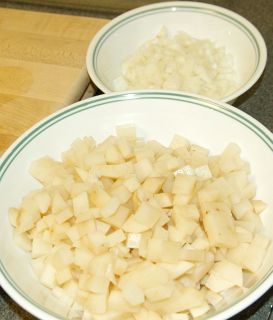 Begin with one pound of diced russet potatoes (about one large potato) and 1/2 cup onion (about 1/2 medium onion). You'll also need a tablespoon of all-purpose flour and two tablespoons of bacon grease.
Begin with one pound of diced russet potatoes (about one large potato) and 1/2 cup onion (about 1/2 medium onion). You'll also need a tablespoon of all-purpose flour and two tablespoons of bacon grease. Drain the clams from two 10-ounce cans of clams (preferably canned in water, salt water, or broth - not oil). After draining, both cans should yield about a total of 10 ounces of clam meat. Also, prepare 8 ounces of clam juice. The flavor is better if you use bottled clam juice instead of the liquid the clams are packaged in, but if clam juice is unavailable, reserve 8 ounces of the liquid from the cans.
Drain the clams from two 10-ounce cans of clams (preferably canned in water, salt water, or broth - not oil). After draining, both cans should yield about a total of 10 ounces of clam meat. Also, prepare 8 ounces of clam juice. The flavor is better if you use bottled clam juice instead of the liquid the clams are packaged in, but if clam juice is unavailable, reserve 8 ounces of the liquid from the cans.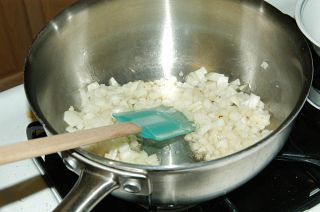 Heat two tablespoons of bacon grease and saute the onions in the hot grease until translucent, but not browned. Bacon grease can be collected and stored after you cook bacon. If you don't have any bacon grease in your refrigerator, go ahead and cook about four slices of bacon in the pan and remove the bacon and any excess bacon grease (remember to store it for future use) before sauteing the onions.
Heat two tablespoons of bacon grease and saute the onions in the hot grease until translucent, but not browned. Bacon grease can be collected and stored after you cook bacon. If you don't have any bacon grease in your refrigerator, go ahead and cook about four slices of bacon in the pan and remove the bacon and any excess bacon grease (remember to store it for future use) before sauteing the onions.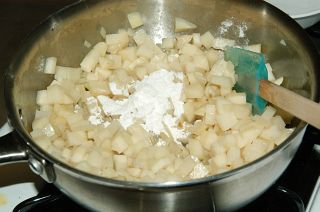 Add the diced potatoes and saute until all the potato has been coated by the fat. Throw in the tablespoon of flour and saute until the potatoes and onions have been coated.
Add the diced potatoes and saute until all the potato has been coated by the fat. Throw in the tablespoon of flour and saute until the potatoes and onions have been coated.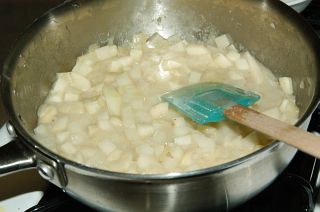 Pour in the cup of clam juice and bring to a boil while stirring. Once the mixture comes to a boil, reduce the heat so it just simmers with the lid on. Cook with the lid on for 20 minutes or until the potatoes are tender.
Pour in the cup of clam juice and bring to a boil while stirring. Once the mixture comes to a boil, reduce the heat so it just simmers with the lid on. Cook with the lid on for 20 minutes or until the potatoes are tender.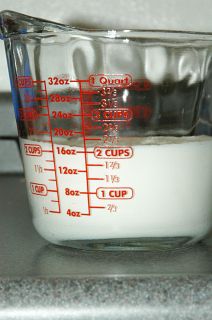 Prepare a mixture of one cup whole milk and one cup heavy cream. Half-and-half will also work as long as it's on the creamier side - if not, augmentation with some heavy cream may be necessary. The amount of fat is important for the texture of the chowder. Using only milk will result in a slightly thickened (due to the potato starch) watery consistency. Using only heavy cream will result in a really smooth, but much too rich chowder. The milk and cream mixture results in a cream fat concentration around 20%, producing what I think is the perfect consistency when served hot or warm. Using combinations of milk and cream to achieve this fat ratio helps us get to our desired consistency target. For example, some light whipping cream (about 18-30% fat content) has a fat content as low as 18%, so using straight light whipping cream of this type will provide us the desired amount of fat.
Prepare a mixture of one cup whole milk and one cup heavy cream. Half-and-half will also work as long as it's on the creamier side - if not, augmentation with some heavy cream may be necessary. The amount of fat is important for the texture of the chowder. Using only milk will result in a slightly thickened (due to the potato starch) watery consistency. Using only heavy cream will result in a really smooth, but much too rich chowder. The milk and cream mixture results in a cream fat concentration around 20%, producing what I think is the perfect consistency when served hot or warm. Using combinations of milk and cream to achieve this fat ratio helps us get to our desired consistency target. For example, some light whipping cream (about 18-30% fat content) has a fat content as low as 18%, so using straight light whipping cream of this type will provide us the desired amount of fat.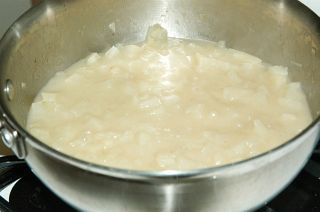 Once the potato, onion, and clam juice mixture has simmered for 20 minutes, stir to redistribute the solids.
Once the potato, onion, and clam juice mixture has simmered for 20 minutes, stir to redistribute the solids. Add the drained clams, milk, and cream.
Add the drained clams, milk, and cream.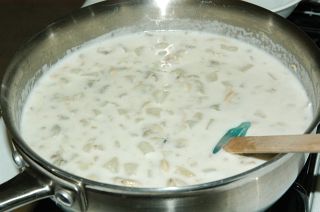 Stir and heat through until hot, but not boiling. (Boiling may cause some of the milks solids to clump - but with 20% fat concentration this is less of a problem than if we were using straight milk. At around 30% or more fat, there is enough fat to prevent the clumping of the milk solids even while boiling.) While heating, this is right time to season with salt and pepper. Add salt a pinch at a time, stir, and taste. Repeat until you get the desired saltiness. It is important not to forget to add the salt and pepper - even though we have a lot of flavors in the chowder at this point, they will be muted without adding enough salt.
Stir and heat through until hot, but not boiling. (Boiling may cause some of the milks solids to clump - but with 20% fat concentration this is less of a problem than if we were using straight milk. At around 30% or more fat, there is enough fat to prevent the clumping of the milk solids even while boiling.) While heating, this is right time to season with salt and pepper. Add salt a pinch at a time, stir, and taste. Repeat until you get the desired saltiness. It is important not to forget to add the salt and pepper - even though we have a lot of flavors in the chowder at this point, they will be muted without adding enough salt.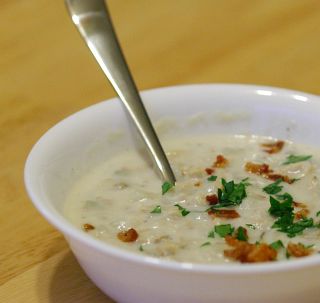 Serve while hot. I like garnishing with a bit of fresh chopped parsley and some bacon pieces.
Serve while hot. I like garnishing with a bit of fresh chopped parsley and some bacon pieces.New England Style Clam Chowder (serves 6)
| 2 Tbs. bacon grease | saute 1 min. | saute 1 min. | stir in | simmer covered 20 min. | heat through without boiling | season to taste |
| 1/2 cup (80 g) chopped onion | ||||||
| 1 lb. (450 g) russet potatoes | peel and dice | |||||
| 1 Tbs. (8 g) all-purpose flour | ||||||
| 1 cup (235 mL) clam juice | ||||||
| 1 cup (235 mL) whole milk | ||||||
| 1 cup (235 mL) heavy cream | ||||||
| 2 10-oz. (283 g) cans whole clams | ||||||
| Salt and pepper | ||||||

1. Precook potatoes in water, drain.
2. Lightly saute onions in grease, remove from pot.
3. Add flour to grease to form roux, cook.
4. Add cream/milk and clam juice and bring to simmer
5. Add precooked potatoes, onions, and clams
6. Heat through, season, serve.
Simple enough, but cooking the potatoes and onions separate is just an unnecessary step and uses multiple pots (unless you are cooking the chowder in your potato boiling pot -- which means an extra rinsing step and you'll be using a much larger pot for the chowder).
However, it should be mentioned that if you are using pure heavy cream, you can probably cook the potatoes in that without worrying about curds forming because of the higher fat content. The only problem I have with that, is that it's a bit too rich for me.
Too busy with the kid's basketball tournament in LA this weekend, but I will definitely give this recipe a try soon!
Thanks, Michael! :)
BG
I really enjoy the site, thanks for taking the time to share.
Have you considered putting the approximate number of servings on your recipes? I am having a tough time figureing out how many people could be served with one batch of chowda.
-Chris.
Yes and no. A sweat is always performed over low heat with the intention of cooking the substance in their own juices (that will flow out and collect as they heat). Often, you'll press foil down onto the ingredients to help retain the moisture as they heat. Sometimes, the term sweat is used loosely for whenever you wish to heat aromatics without browning, but in reality - it's often just a quick saute that's performed. Generally, I consider that if juices collect, then it's sweating - if it's still relatively dry, you're sauteing.
In this recipe, we're cooking the onions just a bit to soften them up for their soak in the clam juice where they will liquify. We're not actually trying to sweat them out in this recipe.
Sorry, I forgot! I've added the servings for this dish: serves 6.
When the liquid is finally added, the sauce will not be lumpy or taste like raw flour. For some reason, if you can actually get the flour to mix directly with a water-based liquid, it still never really toasts up and tastes right.
The important criteria that are behind the "roux first" rule are met, as long as the potatoes aren't too watery, so I would vote to keep the recipe as it stands.
Sometimes I wish could get a bowl of clam chowder on Tuesday.
I think the reason chowder is usually served on Fridays comes from an old Roman Catholic tradition of having only fish on Fridays. Many RCs were poor (long ago) and to help out the starving masses, there was a papal decree that only fish and seafood should be served on Fridays because of its low price and freshness. This ended long ago, but the tradition still remains, as seen in some older practitioners and on our menus.
A lot of factors come into play to control thickness. Increasing the flour will help, but to ensure that their is no raw flour taste, I would probably recommend cooking the flour in butter first to form a roux. Witht he small amounts of flour we used in this recipe, the cooking stage with the potatoes was enough to cook the flour, but with more flour, it's probably better safe than sorry. Don't overcook the roux because as it gains flavor it will lose thickening power.
Next, make sure you use starchy potatoes like russets. Add them to the pot after ocoking without additional rinsing that that will ensure that all the potato starch gets into the chowder.
After simmering the potatoes in clam juice, you can check to see how much liquid is left in the pot. If it's quite a bit, just continue to simmer until most of the liquid is gone. This will produce a thicker chowder as well.
Using only heavy cream will also make a thicker soup.
How these tips will help you achieve the thickness that you're looking for.
keep up the great site....
Restaurants serve these items so that they can draw in this crowd who would normally not eat meat, cloven-hoofed animals to be more precise.
I couldn't say one way or the other how strict this 'rule' is followed these days.
I actually prefer canned chopped (not minced) sea clams to whole canned clams, but I'll take quahogs in the shell over any of the above. If you heat the milk gently (just until warm) before you add it to the chowder, it won't separate.
In other news, Yukon Golds make great chowder potatoes.
Got hopelessly addicted to it - and "hopeless" is not a figure of speech here. I live in Brazil, but usally come on business to Sunnyvale, California, only once or twice a year.
Thank you sooooooooo much for the fantastic recipe you've shared (the best I found in the Web), so I don't have to spent 50 weeks of the year whining and yearning for this delicious chowder. Gonna make it at home and will probably live on it from now on. :D
I start with bacon grease for flavor and end with a sprinkle of bacon pieces when I serve.
Nei Ho Ma?
Nice article Michael.
I've been looking for a southern-bahamas style clam chowder, will share if I come across anything worthwhile, do you have any recipes for this?
Graham
I'm celebrating!
Thanks for the recipe. All the best. R
The Catholic Church, as well as most of the various Orthodox Christian churches, still have prohibitions regarding meat on Fridays, as a sacrifice symbolic of that on Good Friday. Western Catholic tradition holds that its members from ages of at least 14-65 should abstain from eating "flesh or fowl" on Fridays. The Greek Orthodox church, if I recall correctly, asks its members to abstain from eating vertebrates.
This is for Fridays year round, not just in Lent.
Different conferences of bishops may redefine the specifics of the fast. For instance, the United States Council of Catholic Bishops decreed in the 50's that Catholics in the US must abstain from meat, or make some other penitential act.
Thus, few actually follow this directive today, but the custom still stands. The cafeteria at my workplace offers seafood dishes typically on Friday only.
I hail from Maine, where the chowder is what keeps us going all winter long, and I must say cookbooks ALWAYS get maine chodwer wrong!
For the best results, boil your claims seperately, then shuck and clean them....
After, you use heavy cream and Maine Round White potatoes (Or california long whites if you can't get maine whites). The white potatoes are also called All-Purpose potatoes. They have a medium startch content.
Add your diced onions and taters (peeled or not, you're choice, I prefer them dirty) to the heavy cream, and some sugar to taste. (Yep, I said sugar). You don't want to bring this to a boil, instead it takes some active time to keep the temperature around 190 Degrees F.
It takes about an hour to simmer, at about 45 minutes, the cream will be quite thick, and the potatoes nearly done. So, add in your clams and then use the clam juice to thin out the cream.
In liue of Salt pork, we actually tend to use Bacon. You cut up as much bacon as you want in your chowder and let it cook with the potatoes etc.
Anyway, this is why resturaunt chowder sucks so much south of Maine....if you want the best chowder, make it yourself. Most resturaunts start with either canned clams or canned chowder, which tastes horribly bland.
You can then garnish it with cracked or freshly ground pepper corn, and a few sprigs of parsely.
While walking the dogs on the beach this morning at low tide I saw a few holes in the sand and started digging...came up with 8 rather large butter clams and took it from there. The only thing I did differently from the recipie was rendering actual bacon for the fat content and leaving it in the chowder.
MMM, MMM GOOD! Thanks for coming up with a great recipie! You have "Cooking Alaskan", "New York Times Cookbook", and "Joy of Cooking" chowder recipies beat all to heck.
Veritas on Salmon Beach, Washington
Thanks again,
Veritas in Salmon Beach, Washington
I will be back again soon for more great adventures into the land of cooking!
Thanks for the great site... it's one of the best i've found, congrats on the great work.keep it up :)
Is there anything non starchy or sugary that could be used as a substitute?
parsnips and turnips come to mind - not sure that fits in the non-starch role, tho
As John posted above, the starch from the potatoes helps to thicken chowder. This, as well as well-rounded flavor, is why the potatoes should not be boiled separately and then added to the chowder. A flour and fat combo is a roux although in this recipe it's not prepared as a traditional roux. Whichever way works best to achieve the result you personally prefer is the one you should use. While it may not be "the" original New England version, the preparation as presented here is quite common in New England restaurants and home kitchens today.
It's not a great idea to freeze chowder as both the dairy products and the potatoes will lose their integrity, and reheating will result in a significantly different texture and appearance. Substituting parsnips or turnips for potatoes is not recommended because they are both much stronger flavors and would overwhelm the delicate flavor of the clams.
Thank you for sharing this recipe.
To make this Rhode Island chowda you need the following:
Quahogs
Potatoes
Onions
Bacon or Chirico
salt n pepper
Water
Milk
Take your quahogs, wash em with a brush, and put them in a big pot. Cover with water. Put on very low to medium heat to cook them just enough to open them up.
While your clams are cooking dice either two slices of bacon or a small piece of chirico. Place this in a frying pan for 5 minutes then add your chopped onions. Cook together until the onions are soft and just beginning to brown. Remove from the fire.
Take you quahogs and shuck them over a bowl. Chop em. Put them in the bowl with the juice that you have collected.
At this point you have the onions and the clams cooked and your juice. Sometimes I use the water from cooking the quahogs , strain it to remove any sand etc, then cook the potatoes with it.
When the potatoes are half cooked add the rest of the items. Add salt and pepper to taste. At this point you have two choices. Continue and eat it. Or freeze it.
Take some whole milk and being to whisk it into the chowder. Bring it to a boil and then remove it from the heat and serve right away. Garnish with a little dab of butter and paprika.
Thats my story.
At any rate, we dug clams today, tried this recipe made with our fresh clams, and it was scrumptious...all nine of us who ate it agreed! That is all that matters, how it tastes to you. If you don't like it, go post your recipe on your own site and let people decide for themselves.
Thanks for this recipe!
As for eating fish on Friday, I think the real reason is because when you cook fish it stinks up the house. If you cook it on Friday night, you have time to clean the house on Saturday morning thus freshening away the fish funk!!! Ha Ha!!
Try it.
I'm not very experienced at cooking yet, so still not sure what I can substitute for what...
lard is rendered pork fat - so yes it can be a substitute.
bacon grease adds a bit of 'bacon flavor' - but actually any fat (butter, etc.) can be used.
living in Viroflay, near Versailles and Paris
I used to travel in the US, Boston, Salem, San Francisco, San Jose,
Washington, Baltimore , Annapolis, I love so much the country.
I will try the clam chowder i tasted in Boston and Frisco.
Thanks a lot
Bill
My question is two-fold: if I wanted to make this for a group of people, do I simply follow the recipe and multily by 5? (Need to serve 30) Or make it in batches and follow the original recipe?
Also, in your opinion, would this be a good recipe to make, then take to a pot luck and reheat in a slow cooker?
Try it.
What a great idea, I will try it!!
Silly question, how long is a good time to allow the flavors to blend? I made mine and we ate it right away, it was delicious, but I bet it would've been even better if I'd made it the night before....
not sure the New England style needs a lot of "flavor melding" time - as opposed to the Manhattan style which needs to extract/blend the leafy herbs and vegetable.
I should think a hour, perhaps two is max. benefit. depending on the potato you use (hi/lo starch, there's a debate...) making it too far ahead and holding it could result in unintentional thickening as a starchy potato breaks down.
Thanks.
in a home kitchen, you'll probably use something like a stock pot. the problem with one huge batch is a small heating area (the pot bottom) to a tall volume. even with stirring I would not expect an even heating throughout the pot - given it's a something viscous mix.
two large diameter pots would be my approach . . .
Phillip in Lexington, KY
see http://www.europegourmet.com/category.sc?categoryId=8
there are multiple spellings and of course no two brands taste exactly alike either.
I figured I was just lucky with the "blend" and have never deviated. Our customers would revolt. I don't usually get so lucky when blending recipes, so I can't wait to check out more of yours...!
thanks
However, the result didn't impress me. I added salt to taste but it's kind of bland and I had to give it a quick pulse with my immersion blender to thicken it up a little. After chucking in a hunk of butter, the flavour improved tremendously, but it's still not that impressive. I hope my boyfriend likes it better than me. Maybe I'm just a sucker for butter.
well, clam chowder is all about the clams - it is not a rip-out-yo-taste-buds savory type dish. not sure I would describe "clam" as a 'delicate' flavor, but it's not in the same class as say pepperoni.
as to some specific questions, bottled juice vs canned - not an issue. if it is an issue it is the brand of juice being more or less 'better' - not can vs bottle
thickening: most of that comes from the potatoes; minor amount from the heavy cream reduction. a high starch potato type is best - and even that depends on variety and how cooked they are - slightly overcooked will give you some "freely available starch" a waxy type potato will not provide much thickening at all. regardless, a quick pass with the boat motor is entirely in order.
if you have the option, supermarket shelves being what they are, check out different brand names of clams and juice. they do vary. and if you have the availability - fresh clams will certainly set your taste buds in motion - steam them until they just open, scoop out the goodies, save the steaming juice for the chowder. there be clams, and then there be _clams_!
well, clam chowder is all about the clams - it is not a rip-out-yo-taste-buds savory type dish. not sure I would describe "clam" as a 'delicate' flavor, but it's not in the same class as say pepperoni.
as to some specific questions, bottled juice vs canned - not an issue. if it is an issue it is the brand of juice being more or less 'better' - not can vs bottle
thickening: most of that comes from the potatoes; minor amount from the heavy cream reduction. a high starch potato type is best - and even that depends on variety and how cooked they are - slightly overcooked will give you some "freely available starch" a waxy type potato will not provide much thickening at all. regardless, a quick pass with the boat motor is entirely in order.
if you have the option, supermarket shelves being what they are, check out different brand names of clams and juice. they do vary. and if you have the availability - fresh clams will certainly set your taste buds in motion - steam them until they just open, scoop out the goodies, save the steaming juice for the chowder. there be clams, and then there be _clams_!
I should clarify - by "stuff in the cans" I meant the juice that was packed with the clams, which isn't clam juice at all but rather water that has had the clams soaking in it.
I am not sure how to choose a high-starch potato - where I live, they are divided into "Yellow flesh", "White" and "Red" potatoes. I like the yellow flesh because the flavour. Though I'm not sure what kind of potato it is, or any of the other ones.
The yellow flesh potatoes are somewhat more yellow inside than the white potatoes, though they look about the same on the outside. The skins are very thin and I never remove them. The only difference between the white and red potatoes seem to be the skin (they could have others but I have never noticed them).
I don't live in an area where fresh seafood is readily available, and even then, I don't think I'd have time to go through shucking all the clams I'd need for a recipe such as this! Nor carrying them home from the supermarket... can't imagine what a gigantic bag I'd need to carry them all.
white potatoes are often called "all purpose" - they range in the middle regarding starch
reds, fingerlings, yukons are low starch.
juice from the clam can - that works!<g>
our markets (sometimes) have fresh chopped clams in a container. worth a try if you find them!
The guideline on having 18%-30% fat content was a good gauge. I used approximately 230 ml of cream (20% fat) and 200 of milk (low fat though). I was quite worried that the texture might not turn out well. But it was great!
Thank you for your recipe and I am glad my first attempt at clam chowder was a good one! :)
I got confused about the best order of operations, which made me call myself all sorts of unkind names. So it was funny (and helpful) to find the discussion "roux first" on this site. (I usually opt for the "messy kitchen" method.)
Anyway, thanks to everyone who is so generous with their knowledge.
Rose
First off, NE CC. is started with Salt Pork (for the flavor) and for the fat to cook the onion in.
I use, as did my Mother and her Mother before her, Soft Shelled, Quahogs, Sea Clams or the like.
Use clam juice or save the clam broth from steamers the night before.
Do the usual sauteing of the onion, then add the diced potatoes and lastly the clams. However, and this is the real kicker: we always used evaporated milk in our NE Chowder. Top it all off with some cream (usually this was from the top of the milk bottle in the old days). Sprinkle some paprika on top with a generous pat of butter and put in the refrigerator until the next day. This affords the chowder to take on all the luscious flavors.
Reverend Bob
Love the word LUSCIOUS....will try this method.
as you can see in this and many other discussions, there is no such thing as 'the one and only authentic' <fill in the dish>
if you liked your local chef's chowder, go with his directions.
Cream Cheese works great. It adds really great thickening that holds up to freezing better.
I like to begin with clarified butter to saute the onions and potatoes. Salt pork is mild enough, but bacon can impart too much smoke flavor.
Have to agree on adding thyme, along with a small amount of white pepper you will have a much more flavorful chowda.
Finally, I use both russets and yukon golds. The russets will help thicken and the yukon golds impart buttery creaminess.
I think I will saute the clams a bit before putting in soup--it was too raw for my taste in the final soup.
I used fresh cilantro leaves for garnishing, and it went wonderfully well with the soup.
I am sure as I keep making it and get better at cooking, it will be better, but any other ingredients for a possible increase in flavor?
a lot of the thickening potential comes from the potatoes - which are a variable - some break down more than others. a high starch variety (like russets) is preferred - but even russets vary. but it's not unheard of to tweak the consistency.
also to think on - potatoes benefit from salt - brings out their flavor. you might try a touch more next batch.
past that it's pretty much all about the clams - if you can get live clams that's the best taste approach - I find the canned clam does lose a lot of its flavor.
reducing the clam juice prior to adding is another 'clam it up' trick.
I like to use a sharp yellow onion - a little bit of mild onion can get lost. I probably use double the onion of this recipe.
I also use chopped parsley or fresh chives stirred in and cooking end.
personally I don't keep bacon fat around, so I fry up 4-5 slices to get the fat - done to crispy crisp state, the crumbled bacon goes on top just prior to service.
if you want more fancy, finely diced hard boiled eggs is another nice 'floater' for presentation.
Since Dustin implied he was new to cooking, I thought I'd clarify what Dilbert means by "reducing". He doesn't mean reducing the amount of clam juice used - in kitchen-speak "reducing" means to concentrate by way of boiling/simmering. The volume is reduced, but the flavors are concentrated.
I visited a restaurant called the "Nautical Wheel". It was fabulous, I even left a 30 dollar tip,(more than the meal cost then) the waitresses were just unbelievable, they each took turns in sitting with my group and told us of the history of the place. I have never experienced anything like that anywhere else in the World with waiting staff. I sincerely hope they are still in operation.
I have made my own version of it many times since, and it is one of my favourite dishes from anywhere in this World.
Mike.
As far as I am concerned, New England style is clam chowder, and that Manhattan stuff is just a weird, red soup that happens to contain clams. :)
clam juice is essentially the pot liquid from steaming clams - so indeed you can start with fresh clams!
I usually steam them with some onion / celery / salt - just strain out the solids and you've got 'instant' clam juice. you can also reduce it very gently to help concentrate the flavor.
working with canned clams usually does not produce enough liquid - hence the bottled clam juice booster.
Cheers
W
We here in New England love to argue about anything, and everything. A very important things to us is our group identity, which is in part defined by our geography.
A prized characteristic here is to be honest to others. That's why when you ask someone "How are you today?" they might respond with "Horrible, I'm just having one hell of a day." Think I'm lying? Look at the Boston Herald comments about the Red Sox. We're a bitter and angry group of people. And when people make mistakes about us, we care, and we love to point out flaws. Hence the voluminous response response to a tiny geographical error.
I think if you are going to cook New England food, you might try on our emotional angst and bitterness while you're cooking. Just for kicks! Scowl the whole time you cook.
Wikipedia is wrong. Just for the record, here is how Bostonians define New England:
NYC is not New England. Half of Connecticut is not New England either; it is Suburban NYC or "The backyard" or the city. Yankee fans too.
All of Mass, Vermont, R.I., New Hampshire and Maine are in New England.
Many consider New Brunswick, PEI, and Nova Scotia, and Newfoundland to be a part of New England, but generally we term this group "Maritime States" because it's Canada, even though we do share "New England" cultural heritage with them.
Quebec is Not New England; is is French Canadia.
Secretly, we all wish NYC was a part of New England, but our angst gets in the way. Probably the day we admit we like NY, we'll get annexed.
I have been making a version of chowder for years that my family loves.
I always make a huge potful because they eat it for breakfast and lunch the next day.
Since our family rarely goes by breakfast conventions, it is rather sweet to see them eat and enjoy huge bowlsful of it the next day and ignore other food.
What is a standby menu with the chowder is cornbread or a whole grain quick bread, and an apple crisp for dessert, no ice cream or whipped cream.
The arguments about ingredients and geography etc. do not change the fact that New England Clam Chowder is fabulous.
I love this receipe. Thanks for all the detail and pictures, as it really helps to know what things are supposed to look like at various stages. My husband loves clam chowder, so I just made this version last weekend and it was the best we've ever tasted.
Brenda K
We just made the New England Clam Chowder. It was the best that we have ever had.
Congratulations! :)
First I did use bacon. and very thick lean and tasty type. Second I used fresh Razor clams I got my self. third I used two sprigs of garlic and several good shots of Tabasco sauce as my seasoning to taste
On the making process I chopped the clams into very small pieces and cooked them separately in a pan with the garlic till not quite brown, draining off the juice into the the already cooking potatoes. Every thing else I did as your recipe asked..
Thanks again it's nice to look up on the Internet a recipe and have it turn out good. I'll print and keep this one.. :)
I use fresh clams, not canned ones (must cook separate because of the sand still coming out - even after draining), did the roux etc.
But maybe, I just like cooking :P
Thanks for the recipe, a great guide!
It is off somewhere, and I can't quite tell what it is. I'm thinking it might be the clam juice, or it might be the starch from the potatoes. I added some butter and it did help. For what its worth, the lady liked it.
Thanks for the recipe!
Kristen
philawriter.wordpress.com
Hope for answer soon - I'm on leaving Wed 10/26 to Mexico - and YES I do my own clamming.
bottom line yes, recipes are usually flexible to minor changes in proportions _except_
seasonings - some are "stronger" than others and less than x6 will work - a minor "generality" in this case as the recipe is just salt&pepper
"thickening" - one single huge pot is is going to cook differently - in particular the amount of starch coming out of the potatoes - so don't put in all the x6 liquids at one crack - hold off to see how it thickens up and be prepared to add more or less liquid than the x6 math indicates.
WEST COAST ALL THE WAY BABY!
Using Fresh clams:
Today I made an over-sized recipe with 2 dozen clams ranging from "Cherrystone" to large "Quahog" size, and it is again marvelous. Washed, then soaked the raw clams in water with corn starch and salt, then rinsed them again. Steamed the clams open, saved the broth (let the sand settle out) and used this instead of bottled clam juice. Same as before using baby white skin-on spuds. Wow-ee.
With fresh clams (and no food processor nearby for chopping - lost it in Hurricane Irene and haven't replaced it yet) it's quite a bit more time-consuming, but I'm not complaining - it was worth it!
We are all um... happy as a clam here.
Thanks again!!!
-PJ
Our brother in law, who is from Boston, LOVED it too. He and his wife said it was the better than a restaurant. So decadent.
I've made it a few times now, and it's always received rave reviews. I figured it was time for me to post a big Thank You!! I love your site and learning the science behind the ingredients. You have made me a better cook.
Add flour and throw the mess out.
Reduction and butter makes the chowder.
Salt Pork is the only option, it is found in grocers everywhere.
Any thing else comes from furiners
Yeah, the chart makes it easily understood. Hope others would also present their recipes in that way :lol:
Yes, we can say this is correct.